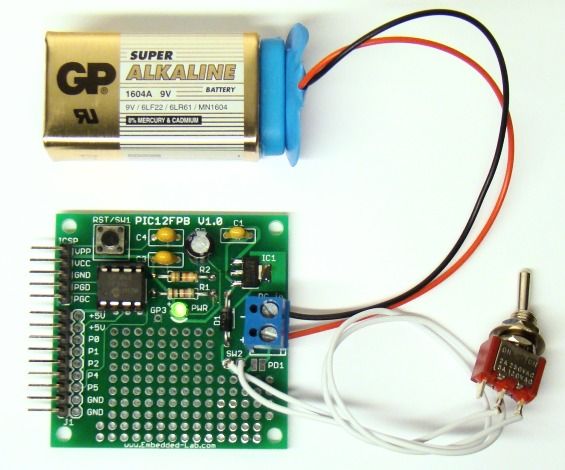The 12F series of PIC microcontrollers are handy little 8-pin devices designed for small embedded applications that do not require too many I/O resources, and where small size is advantageous. These applications include a wide range of everyday products such as hair dryers, electric toothbrushes, rice cookers, vacuum cleaners, coffee makers, and blenders.
Despite their small size, the PIC12F series microcontrollers offer interesting features including wide operating voltage, internal programmable oscillator, 4 channels of 10-bit ADC, on-board EEPROM memory, on-chip voltage reference, multiple communication peripherals (UART, SPI, and I2C), PWM, and more. The following project board is designed for fast and easy development of standalone applications using PIC12F microcontrollers. It features an on-board regulated +5V power supply, header connectors to access I/O pins, an ICSP header for programming, a reset circuit, and a small prototyping area for placing additional components.
Circuit diagramThe following circuit shows the on-board +5V power supply unit using AMS1117-5.0V regulator IC. The maximum output current of AMS1117 is 800mA, but it is recommended to limit the maximum current to 500mA. The project board can be powered from a 6-12V external power supply connected through a 2-pin terminal block. There is no power ON/OFF switch on-board but users can connect one externally. If no external ON/OFF switch is connected, the pads shown in the figure below must be shorted through soldering.
The microcontroller circuit (shown below) is straightforward. The GP3/MCLR pin is connected to an external tact switch that can be configured as a reset switch (if MCLR is enabled) or a user input (if MCLR is disabled). All I/O (GP0, GP1, GP2, GP4, and GP5) and power supply (+5V and GND) pins are accessible through headers. A header connector for ICSP using PICKit2/3 is also provided on board.
Although GP3 is connected to the tact switch input, you can still access it through a plated through hole (PTH) on lower right side of PIC12F IC socket and is labelled as GP3 on PCB (see picture below). There’s a small prototyping area available on the board to add additional components for user projects. If an external ON/OFF switch is to be added into your application, it must be connected to two PTH marked as SW2. Otherwise, the PD1pins must be shorted together for continuous power supply. The picture below shows a closer view of the features on board.
For more detail: Mini project board for PIC12F series microcontrollers

